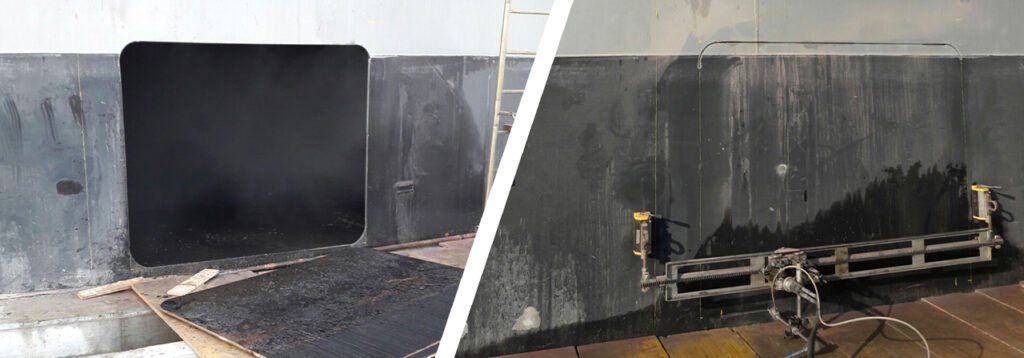
Cold Cutting Services for Storage Tanks
At Tanqeb, we specialize in cold cutting solutions to safely and efficiently address storage tank damage, even when the tank remains full of hazardous or flammable products. Using advanced anti-explosion cutting technologies, such as water jet cutting or specialized cold cutting equipment, we provide a safe, non-thermal approach to cutting or repairing storage tanks in critical conditions.
What is Cold Cutting?
Cold cutting refers to cutting processes that do not generate heat, sparks, or flames. This method is particularly vital in environments where flammable products, vapors, or hazardous substances are present, as it eliminates the risk of ignition or explosion. Our cold cutting services are suitable for a wide range of materials, including steel, concrete, and composite structures.
When is Cold Cutting Necessary?
Cold cutting is essential in situations where:
- A damaged storage tank is filled with flammable or hazardous products.
- Hot work (such as welding or torch cutting) poses safety risks due to the presence of flammable vapors.
- The cutting or dismantling of a structure needs to be performed with precision and safety.
- Environmental protection is a priority, preventing contamination from heat-related processes.
Our Cold Cutting Services
Tanqeb offers a range of cold cutting solutions tailored to meet your specific needs:
- Water Jet Cutting
- High-pressure water jets mixed with abrasive materials cut through thick metals and other materials with precision.
- Ideal for storage tanks filled with flammable products as it eliminates the risk of sparks or heat.
- Provides clean cuts with minimal residue or damage to surrounding structures.
- Specialized Mechanical Cutting Tools
- Use of advanced mechanical cutting tools for controlled, spark-free cutting of metal surfaces.
- Suitable for tank openings, dismantling, or repairs in sensitive environments.
- Cold Pipe Cutting and Beveling
- Effective for pipes connected to tanks or other structures without disrupting operations.
- Provides precise cuts and bevels without generating heat or compromising safety.
- Controlled Section Removal
- Safe removal of damaged sections of tanks for repairs or modifications.
- Ensures minimal disturbance to the product inside the tank.
Advantages of Cold Cutting
- Enhanced Safety: The absence of heat, sparks, and flames reduces the risk of ignition and explosion.
- Precision Cutting: Provides accurate cuts without compromising the integrity of the surrounding structure.
- Environmental Protection: Prevents heat-related damage and minimizes the risk of contamination.
- Adaptability: Effective on a wide range of materials, shapes, and sizes.
- Minimized Downtime: Allows for rapid and efficient repairs or modifications without extensive interruptions to operations.
Why Choose Tanqeb for Cold Cutting?
- Experienced Professionals: Our team of experts is highly trained in cold cutting techniques, ensuring safety and efficiency.
- Advanced Equipment: We utilize state-of-the-art cold cutting tools and technologies for reliable results.
- Customized Solutions: Each project is tailored to meet the specific needs and challenges of your tank and product.
- Safety-First Approach: We prioritize the safety of your personnel, environment, and assets in every service we provide.
- Compliance with Standards: Our methods meet industry safety and environmental standards, including API, OSHA, and local regulations.
Applications of Cold Cutting
- Emergency repairs for damaged storage tanks.
- Modifications or retrofitting of tank components.
- Tank dismantling and decommissioning.
- Creating access points for inspection or maintenance.
- Cutting operations in hazardous or restricted environments.


